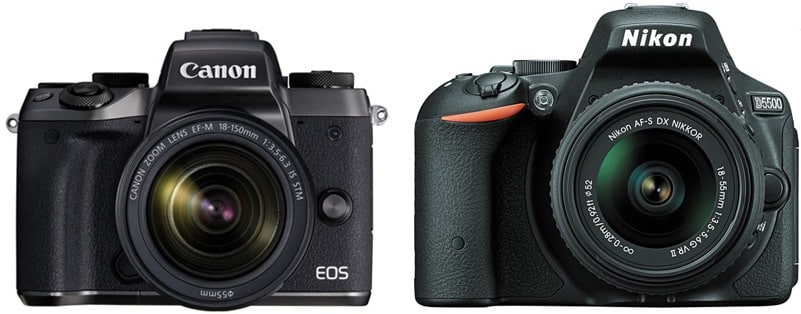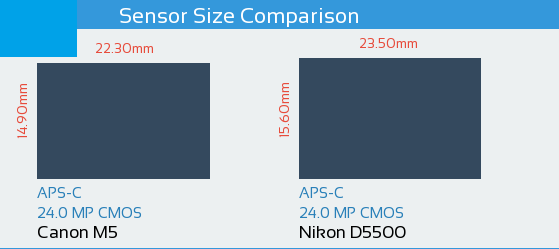Canon M5 vs Nikon D5500
: Two cameras. Two different body types. This article compares Canon’s Semi-Pro Mirrorless camera, the Canon EOS M5, with Nikon’s Entry-Level DSLR, the Nikon D5500. Both cameras feature a 24.0MP APS-C sensor. To start, here’s a brief overview of the main features of both cameras.
Canon M5 vs Nikon D5500 Specs

Canon M5 vs Nikon D5500
Specifications |
Canon M5 |
Nikon D5500 |
|---|---|---|
| Megapixels | 24.2 | 24.2 |
| Sensor Type | CMOS | CMOS |
| Sensor Format | APS-C | APS-C (DX) |
| Crop Factor | 1.6x | 1.5x |
| AA Filter | Yes | None |
| Image Resolution | 6000 x 4000 | 6000 x 4000 |
| Body Image Stabilization | Yes (Movie only) | No |
| Lens Mount | Canon EF-M | Nikon FX/DX |
| ISO | 100 – 25,600 | 100 – 25,600 |
| Expanded ISO | None | No |
| AF Points | 49 Hybrid | 39 |
| Cross-type AF Points | Dual Pixel AF | 9 |
| Continuous Mode | 7fps | 5fps |
| LCD | 3.2″ – Articulating | 3.2″ – Fully Articulated |
| LCD Resolution | 1,620,000 dots | 1,036,800 dots |
| Touchscreen | Yes | Yes |
| Focus Peaking | Yes | No |
| Top LCD Display | No | No |
| Viewfinder Type | EVF (2.36M) | Optical |
| Viewfinder Coverage | 100% | 95% |
| Viewfinder Magnification | 0.82x | |
| Video Resolution | 1920×1080 (60/50/30/25/24p | 1920×1080 (60/50/30/25/24p |
| 1280×720 (60/50p) | 1280×720 (60/50p) | |
| Microphone Jack | Yes | Yes |
| Headphone Jack | No | No |
| Memory Card Type | SD | SD |
| Dual Card Slots | No | No |
| SD UHS Support | UHS-I | UHS-I |
| Fastest Shutter Speed | 1/4000 | 1/4000 |
| Slowest Shutter Speed | 30″ | 30″ |
| Bulb Mode | Yes | Yes |
| JPEG Buffer Size | 27 | 100 |
| RAW Buffer Size | 18 | 7 |
| Time Lapse | Yes | Yes |
| Built-in Flash | Yes | Yes |
| Max Flash Sync Speed | 1/200 | 1/200 |
| Startup Time | 1.2s | 0.4s |
| Built-in Wi-Fi | Yes | Yes |
| Built-in GPS | No | No |
| Built-in NFC | Yes | No |
| Bluetooth | Yes | No |
| USB Type | USB 2.0 | USB 2.0 |
| Environmentally Sealed | No | No |
| Battery Life (CIPA) | 295 shots | 820 shots |
| Battery Included | Yes (LP-E17) | Yes (EN-EL14a) |
| Weight | 15.0 oz (427g) | 14.8 oz (420g) |
| Size | 4.6 x 3.5 x 2.4″ | 4.9 x 3.8 x 2.8″ |
| Price | Amazon | Amazon |
| Release Date | 2016 | 2015 |
Nikon D5500 vs Canon M5 Common Features
| Wireless Connection | Yes vs Yes | Better connectivity |
| Articulating Screen | Yes vs Yes | Flexible shooting positions |
| Built-in Flash | Yes vs Yes | Useful in low-light |
| External Flash Shoe | Yes vs Yes | Better for flash photography |
| Touch Screen | Yes vs Yes | Easy control of camera functions |
| Viewfinder | Yes (Electronic) vs Yes (Optical) | Better framing and control |
| RAW Support | Yes vs Yes | Better image quality |
| Face Detection Focus | Yes vs Yes | very handy for portraits |
| Max Resolution | 24 MP vs 24 MP | Bigger prints and more details |
| LCD Screen Size | 3.2″ vs 3.2″ | Large display |
| Microphone Port | Yes vs Yes | High-quality audio recording option |
| Timelapse Recording | Yes vs Yes | creative shooting |
| AE Bracketing | Yes vs Yes | Useful for tough lighting conditions and HDR |
| Selfie Friendly LCD | Yes vs Yes | Rotate LCD for taking Selfies |
Canon M5 vs Nikon D5500 Size Comparison
The Canon M5 is unquestionably the smaller of the two cameras. Its body is 8mm narrower, 8mm shorter and 9mm thinner than Nikon D5500. However, the Nikon D5500 is 7g lighter than the Canon M5. Although, this weight difference is insignificant.

Canon M5 vs Nikon D5500
Moreover, both cameras have an APS-C sensor. Hence, the lenses they use are practically the same. So, when factoring in the weight, this is not an issue.
Canon M5 vs Nikon D5500 Sensor Comparison
Both the Canon M5 and Nikon D5500 have APS-C sized 24.0 MP resolution sensors so sensor size and resolution are the same between the two cameras.
However, it is worth mentioning that the Nikon D5500’s sensor lacks anti-alias (Low-Pass) filter. This increases the sharpness and level of detail however it also increases the chance of a ripple effect in certain pictures.

Canon EOS M5 vs Nikon-D5500 Sensor Comparison
As both the Nikon D5500 and Canon M5 have the same sensor sizes, they provide a good level of control over the depth of field when used with same focal length and aperture. However, the Nikon D5500 has a 1.1x larger sensor area than the Canon M5. Larger sensors give you more control over the depth of field and blurry background compared to the smaller sensor when shot in same focal length and aperture.
Canon M5 Advantages Over Nikon D5500
| Number of Focus Points | 49 vs 39 | 10 more focus points |
| LCD Screen Resolution | 1.620k dots vs 1.037k dots | 56% higher resolution screen |
| Viewfinder Coverage | 100% vs 95% | More accurate viewfinder |
| Continuous Shooting | 9.0fps vs 5.0fps | 4 fps faster |
| AE Bracketing Range | ±3 EV vs ±2 EV | Wide Bracketing range is useful for HDR |
| NFC Connection | Yes vs No | Easy wireless connectivity with compatible devices |
| Bluetooth | Yes vs No | Connect your camera to other devices via Bluetooth |
| Smartphone_remote control | Yes vs No | Remote control your camera with a smartphone |
| Digital video stabilization | Yes vs No | Stabilizes your videos in-camera |
Key reasons that might sway you to choose the Canon M5 over the Nikon D5500:
- Body Image Stabilization – It has body image stabilization but it only works in video.
- AF Points – 49 vs 39
- Continuous mode – 7fps vs 5fps. More is better for sports and wildlife since you have more chances of getting a tack sharp shot.
- LCD Resolution – Higher resolution.
- Focus Peaking – Very useful for seeing if your subject is in focus (both photo and video).
- Viewfinder Coverage – 100% vs 95%.
- RAW Buffer Size – 18 vs 7.
- Built-in NFC
- Bluetooth Support
- Size – The Canon M5 is noticeably smaller.
Video: Canon M5 Hands-on Review
Canon’s latest mirrorless camera promises to be an 80D in a smaller package. With 1080p and a reasonable 24-megapixels, is it another flop or does the Dual Pixel Autofocus save the day? Watch as Kai takes you through the pros and cons.
Nikon D5500 Advantages Over Canon M5
| Battery Life | 820 shots vs 295 shots | 525 more frames with a single charge |
| Weight | 420 g vs 427 g | 7 g lighter |
| Flash Coverage | 12.0m vs 5.0m | 7m longer range |
| Sensor Pixel Area | 15.28µm2 vs 13.84µm2 | 10% larger pixel area |
| Price | $697 vs $929 | $232 cheaper |
- AA Filter – The Nikon D5500 has no AA filter.
- LCD – It’s fully articulated.
- JPEG Buffer Size – 100 vs 27. Useful for long bursts.
- Battery Life – 820 shots vs 295 shots.
Video: Nikon D5500 Hands-on Review
You Might Also Like
- Canon M5 vs Nikon D5600: A Complete Comparison
- Canon M5 vs Nikon D7200: A Complete Comparison
- Canon M5 vs Nikon D3400: A Complete Comparison
- Canon M5 vs Nikon D3300: A Complete Comparison
- Canon M5 vs Nikon D7100: A Complete Comparison
- Canon M5 vs Canon M6: A Complete Comparison
- Canon M5 vs Olympus E-M5 II: A Complete Comparison
- Canon M5 vs Fujifilm X-T20: A Detailed Comparison
- Canon M5 vs Sony A6500: A Detailed Comparison
- Canon M5 vs Fujifilm X-T2: A Detailed Comparison
- Canon M5 vs Fujifilm X-Pro2: A Detailed Comparison
- Nikon D7200 vs Sony A6300: A Complete Comparison
- Nikon D750 vs Panasonic GH5: A Complete Comparison
- Canon M5 vs Olympus E-M10 II: A Detailed Comparison
- Canon M5 vs Pentax KP: A Detailed Comparison
- Canon M5 vs Pentax 3-K II: A Detailed Comparison